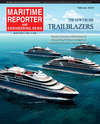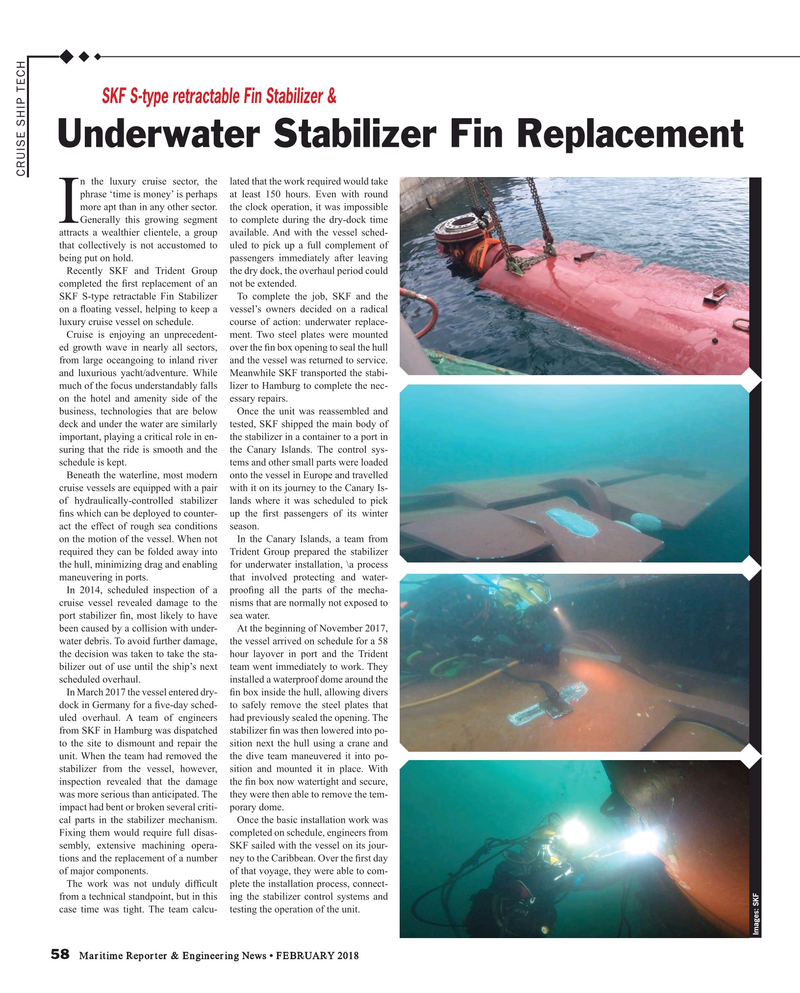
Page 58: of Maritime Reporter Magazine (February 2018)
Cruise Ship Annual
Read this page in Pdf, Flash or Html5 edition of February 2018 Maritime Reporter Magazine
SKF S-type retractable Fin Stabilizer &
Underwater Stabilizer Fin Replacement
CRUISE SHIP TECH n the luxury cruise sector, the lated that the work required would take phrase ‘time is money’ is perhaps at least 150 hours. Even with round more apt than in any other sector. the clock operation, it was impossible
IGenerally this growing segment to complete during the dry-dock time attracts a wealthier clientele, a group available. And with the vessel sched- that collectively is not accustomed to uled to pick up a full complement of being put on hold. passengers immediately after leaving
Recently SKF and Trident Group the dry dock, the overhaul period could completed the ? rst replacement of an not be extended.
SKF S-type retractable Fin Stabilizer To complete the job, SKF and the on a ? oating vessel, helping to keep a vessel’s owners decided on a radical luxury cruise vessel on schedule. course of action: underwater replace-
Cruise is enjoying an unprecedent- ment. Two steel plates were mounted ed growth wave in nearly all sectors, over the ? n box opening to seal the hull from large oceangoing to inland river and the vessel was returned to service. and luxurious yacht/adventure. While Meanwhile SKF transported the stabi- much of the focus understandably falls lizer to Hamburg to complete the nec- on the hotel and amenity side of the essary repairs.
business, technologies that are below Once the unit was reassembled and deck and under the water are similarly tested, SKF shipped the main body of important, playing a critical role in en- the stabilizer in a container to a port in suring that the ride is smooth and the the Canary Islands. The control sys- schedule is kept. tems and other small parts were loaded
Beneath the waterline, most modern onto the vessel in Europe and travelled cruise vessels are equipped with a pair with it on its journey to the Canary Is- of hydraulically-controlled stabilizer lands where it was scheduled to pick ? ns which can be deployed to counter- up the ? rst passengers of its winter act the effect of rough sea conditions season.
on the motion of the vessel. When not In the Canary Islands, a team from required they can be folded away into Trident Group prepared the stabilizer the hull, minimizing drag and enabling for underwater installation, \a process maneuvering in ports. that involved protecting and water-
In 2014, scheduled inspection of a proo? ng all the parts of the mecha- cruise vessel revealed damage to the nisms that are normally not exposed to port stabilizer ? n, most likely to have sea water.
been caused by a collision with under- At the beginning of November 2017, water debris. To avoid further damage, the vessel arrived on schedule for a 58 the decision was taken to take the sta- hour layover in port and the Trident bilizer out of use until the ship’s next team went immediately to work. They scheduled overhaul. installed a waterproof dome around the
In March 2017 the vessel entered dry- ? n box inside the hull, allowing divers dock in Germany for a ? ve-day sched- to safely remove the steel plates that uled overhaul. A team of engineers had previously sealed the opening. The from SKF in Hamburg was dispatched stabilizer ? n was then lowered into po- to the site to dismount and repair the sition next the hull using a crane and unit. When the team had removed the the dive team maneuvered it into po- stabilizer from the vessel, however, sition and mounted it in place. With inspection revealed that the damage the ? n box now watertight and secure, was more serious than anticipated. The they were then able to remove the tem- impact had bent or broken several criti- porary dome.
cal parts in the stabilizer mechanism. Once the basic installation work was
Fixing them would require full disas- completed on schedule, engineers from sembly, extensive machining opera- SKF sailed with the vessel on its jour- tions and the replacement of a number ney to the Caribbean. Over the ? rst day of major components. of that voyage, they were able to com-
The work was not unduly dif? cult plete the installation process, connect- from a technical standpoint, but in this ing the stabilizer control systems and case time was tight. The team calcu- testing the operation of the unit.
Images: SKF 58 Maritime Reporter & Engineering News • FEBRUARY 2018
MR #2 (58-65).indd 58 MR #2 (58-65).indd 58 2/8/2018 10:36:09 AM2/8/2018 10:36:09 AM

 57
57

 59
59
